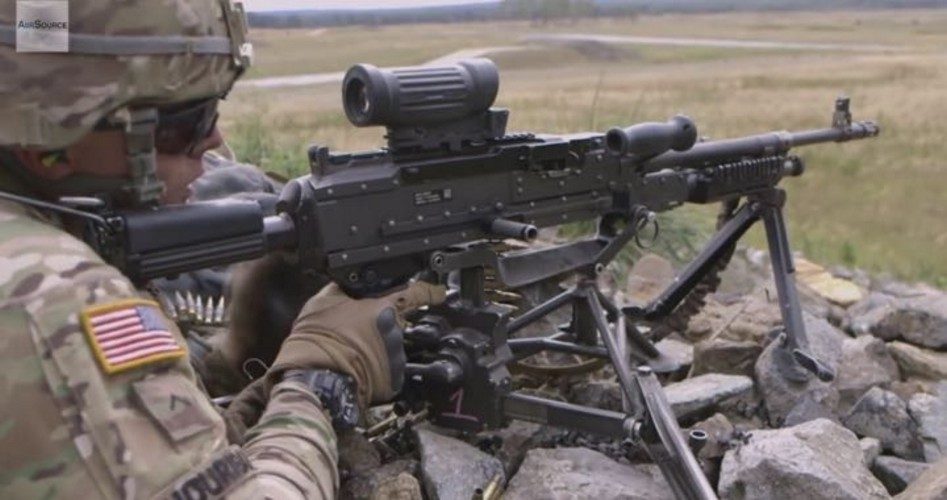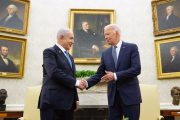
President Donald Trump has given approval to a plan to proceed with the international sale of conventional arms in a manner that will create jobs without endangering national security.
The summary of the plan is set out in a fact sheet published by the U.S. Department of State entitled “Implementation of the Conventional Arms Transfer (CAT) Policy.” The overall aim of the arms sale scheme is “to better align our conventional arms transfers with our national security and economic interests.”
Justin Doubleday, writing for Inside Defense, reports that, “Tina Kaidanow, acting assistant secretary of state for the bureau of political-military affairs, confirmed the implementation plan had been approved in a call with reporters from the Farnborough Airshow in the United Kingdom. Kaidanow is leading the U.S. delegation at the show.”
For those unfamiliar with the Farnborough Airshow, USA Today provides a complete, though brief, description of one of the defense industry’s biggest trade shows:
The 2018 Farnborough Airshow kicked off with a flurry of orders as the year’s largest aviation show opened southwest of London on Monday.
As usual, the competition between rivals Airbus and Boeing is expected to produce one of the top commercial aviation storylines from the biennial show, which alternates yearly with a sister show near Paris.
{modulepos inner_text_ad}
Bloomberg News notes “billions of dollars are at stake as the world’s largest planemakers … duel over orders this week at the Farnborough.”
“Beyond the order avalanche, manufacturers, suppliers and airlines use the event to haggle over contracts and float ideas for new planes and ventures,” Bloomberg adds. “Military chiefs and governments hammer out arms deals and announce defense initiatives. Farnborough … is also a showcase for new technology and ideas, from flying taxis to space flight.”
The show runs through Sunday, though it opens to the public only for the weekend after beginning with several “trade” days for industry insiders. Typically, the biggest deals tend to come at beginning of the shows.
Back in April, President Trump signed a Presidential Memorandum laying out his administration’s aims as pertains to the selling of weapons around the world. Put simply, the president expressed his desire to expand the market for American-made weapons of war into regions of the globe currently cornered by the Russians and the Chinese.
The State Department’s fact sheet says the implementation plan’s trifold mission is “prioritizing strategic competition,” “organizing for success,” and “creating conducive environments.”
These goals will serve as the action plan for U.S. government officials who will work as traveling salesmen, traversing the globe flogging American war machines and materiel to foreign buyers, or, as the fact sheet says, “exploring mechanisms to reduce financial barriers to the procurement of American defense goods and services.”
Perhaps one of the most menacing-sounding action items published in the fact sheet is the last one: “Continuing to improve our arms transfer processes including by establishing milestones and timelines and improving the contracting and procurement processes that underpin the systems.”
That is the sort of language one uses when trying to make the greasing of princely palms and the brokering of backroom deals sound less sleazy and more statesman-like, less like making war and more like making jobs.
Not that job creation isn’t a key component of the president’s Conventional Arms Trade Policy.
In his April memo, the president boasted of the “more than 1.7 million people” currently employed by the American military industrial complex.
“The security of the United States and the defense of our interests require a strong military, capable allies and partners, and a dynamic defense industrial base,” he wrote.
Such zeal for expanding American military influence and spreading our military over the globe didn’t always hold sway in the halls of the federal government.
There was once a time when our statesmen warned against large military establishments, pointing to them as historically the greatest threats to liberty.
Take for just one example of these admonitions, the following paragraph taken from Federalist 46 written by James Madison:
The only refuge left for those who prophesy the downfall of the State governments is the visionary supposition that the federal government may previously accumulate a military force for the projects of ambition. The reasonings contained in these papers must have been employed to little purpose indeed, if it could be necessary now to disprove the reality of this danger. That the people and the States should, for a sufficient period of time, elect an uninterupted succession of men ready to betray both; that the traitors should, throughout this period, uniformly and systematically pursue some fixed plan for the extension of the military establishment; that the governments and the people of the States should silently and patiently behold the gathering storm, and continue to supply the materials, until it should be prepared to burst on their own heads, must appear to every one more like the incoherent dreams of a delirious jealousy, or the misjudged exaggerations of a counterfeit zeal, than like the sober apprehensions of genuine patriotism.
Finally, when one reads President Trump’s touting of our multi-million man defense industry and his announcing while in Europe of this new plan to make it easier for foreign governments to purchase American-made deadly weapons in order that we might “extend our global influence,” “enhance the ability of the defense industrial base to create jobs,” and to “maximize the ability of the United States industry to grow and support allies and partners,” the contrast between our current leaders and those who founded and grew this republic is stark.
Consider the difference between President Donald Trump’s Conventional Arms Transfer Policy as laid out above and the following policy pronounced by President George Washington in his Farewell Address:
The great rule of conduct for us in regard to foreign nations is in extending our commercial relations, to have with them as little political connection as possible. So far as we have already formed engagements, let them be fulfilled with perfect good faith. Here let us stop. Europe has a set of primary interests which to us have none; or a very remote relation. Hence she must be engaged in frequent controversies, the causes of which are essentially foreign to our concerns.
Hence, therefore, it must be unwise in us to implicate ourselves by artificial ties in the ordinary vicissitudes of her politics, or the ordinary combinations and collisions of her friendships or enmities.
Our detached and distant situation invites and enables us to pursue a different course. If we remain one people under an efficient government. the period is not far off when we may defy material injury from external annoyance; when we may take such an attitude as will cause the neutrality we may at any time resolve upon to be scrupulously respected; when belligerent nations, under the impossibility of making acquisitions upon us, will not lightly hazard the giving us provocation; when we may choose peace or war, as our interest, guided by justice, shall counsel.
Why forego the advantages of so peculiar a situation? Why quit our own to stand upon foreign ground? Why, by interweaving our destiny with that of any part of Europe, entangle our peace and prosperity in the toils of European ambition, rivalship, interest, humor or caprice?
It is our true policy to steer clear of permanent alliances with any portion of the foreign world.
Image: Screenshot from youtube video produced by AirSource Military



